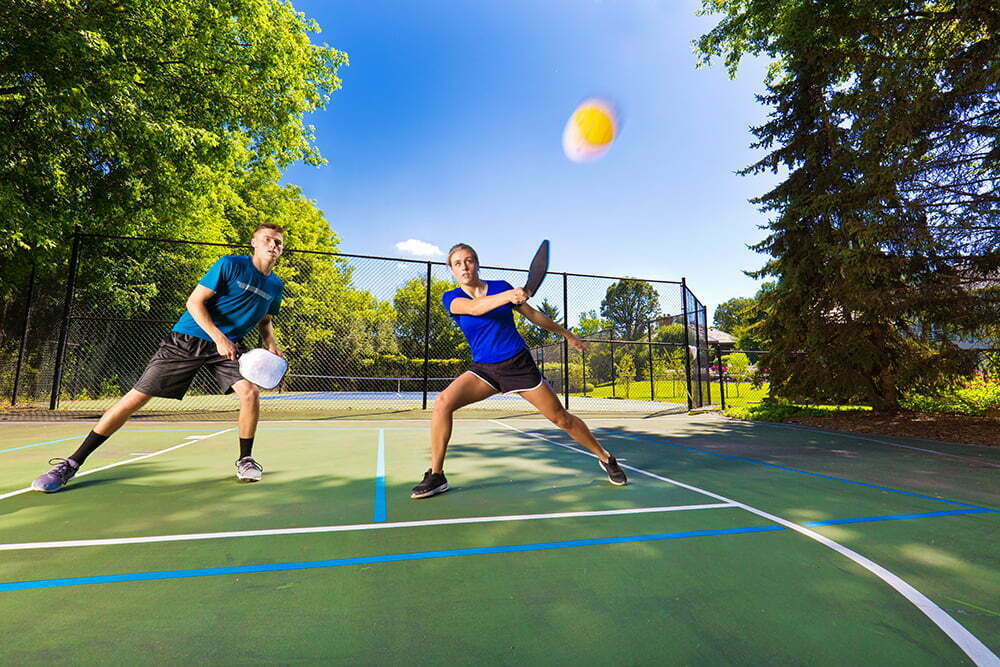Obsessed with Pickleball? 6 Ways to Avoid Injury & Spend More Time on the Court


Pickleball is the new black—at least in the sports world. According to USA Pickleball, the sport’s national governing body, there are currently more than 150,000 active pickleball players in the US, and the number of pickleball court facilities has more than doubled over the last decade. For the uninitiated, pickleball is a hybrid of tennis, badminton and ping pong; here’s a quick video overview.
While it’s not a dangerous sport, the explosion in pickleball popularity has also led to an uptick in pickleball injuries. We’ve noticed because QUICK TAPE® can help relieve many of the most common pickleball injuries, including ankle strains, Achilles tendon strains, plantar fasciitis, and knee pain.
In honor of National Pickleball Month, which is coming up in April, we thought we’d share a few pickleball safety tips and tactics to help you avoid pickleball injuries in the first place.
1. Invest in proper court shoes (not running shoes)
Many pickleball beginners hop onto the court wearing their running shoes or whatever sneaker they happen to own. Unfortunately, this is just asking for injury. Walking and running shoes are designed to provide traction and help you move in a straight line—the opposite of what you want with a game involving fast, frequent lateral (side to side) movements like pickleball. Many injuries come from a running shoe sticking or “snagging” on the court, forcing the knee or ankle to twist and injuring a muscle or tendon.
Court shoes, such as tennis shoes or even pickleball-specific shoes, are designed with smoother, rounder soles to let you move and glide on a court. You’ll pay about the same as for court shoes as any basic running shoes, and they’re well worth it to avoid injury.
2. Warm up before every game
Pickleball involves a lot of quick, dynamic motions from your arms, legs, feet, and core. You don’t want to start a game cold, only to pull a muscle on your first lunge for the ball. Always schedule time for a quality warm-up of at least 5 to 10 minutes, including some easy cardio (i.e., a fast walk, jog, or bike ride) to get your core temperature up, followed by some light stretching.
3. Don’t neglect conditioning exercises
A stronger, more flexible body is much harder to injure. To better your chances of an uninterrupted pickleball career, make sure you devote time to strength training, flexibility and mobility exercises, and other complementary activities to keep your body in top form and avoid overuse injuries.
Even if you hate the gym, there are some basic exercises you can do at home that will help considerably, including squats (weighted or unweighted), push-ups, plank poses, and balance exercises. Even better, take a yoga class—it’ll incorporate strength, flexibility, and good breathing techniques, which will all come in handy on the court.
4. Buy a paddle that’s the right weight for you
Pickleball paddles come in a dizzying variety of materials, weights, and “feels.” It’s important to choose a paddle that feels comfortable and responsive to you. Many players prefer a slightly heavier paddle, but if it’s too heavy for your natural arm and shoulder strength, you’re opening up the window for injuries such as tennis elbow, rotator cuff problems, and shoulder pain.
A good rule of thumb: if your paddle causes your forearm or shoulder to feel fatigued halfway through a normal game, you probably need a lighter paddle.
5. Use your common sense
Dedicated athletes have a tendency to “go for broke” during play and ignore minor aches and pains instead of taking time to address them. But take it from our experience—it’s better to let a point go rather than risk a concussion from running backwards or a wrist fracture from diving for a ball.
If a minor knee or foot injury does occur, it’s better to take a few days off rather than exacerbate it and later need a month or more off for rehab. Seek a doctor’s care ASAP if you have a head injury or severe pain in any area. It’s better to be safe than sorry.
6. Practice preventative care, especially if you are injury-prone
If you have a history of recurring injuries, it’s reasonable to assume they may become a problem when you ramp up your pickleball schedule. Prevent them from holding you back by wearing a brace or taping the area. Not only does taping offer support, we actually have evidence that foot taping for plantar fasciitis can reduce pain and help align the foot.
Think foot taping is inconvenient? There is an easier way: QUICK TAPE straps. Here at Support the Foot, we have many happy pickleball-playing customers. We think it’s because QUICK TAPE is fast to apply, lasts through days of workouts, and is designed to correctly support your foot without your having to follow complex instructions.
The QUICK TAPE® strap lifts the arch, instantly relieving pressure on the plantar fascia, and helps to align the foot, which can both prevent and improve many common foot and lower leg injuries such as Achilles pain, knee pain, shin splints, and heel pain.
We hope you got some helpful info from this list—now go out and play some pickleball (just stay out of the kitchen. 😉
